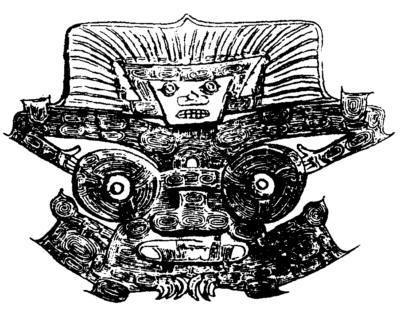Chapter 18 Section 2 The Birth of the Dragon
When prehistoric humans were in a clan society, they believed that there was a special relationship between their clan and a certain animal or plant, or believed that their clan originated from this animal or plant, then this animal or plant was a sacred ancestor and patron saint, This is the "totem".Totem is a word of the Okiwas tribe of North American Indians, which means the emblem or emblem of the clan.Each clan in the clan society has its own totem, and people worship it and think it is sacred and inviolable. This is the totem worship in primitive religion.
The initial totem is often a specific animal or plant, usually animals are more common.In totem art, we can see many half-human and half-animal works, which are the products of the humanization of totems.In the end, the totem was completely personified, and the primitive religion developed towards ancestor worship. In the end, human beings believed that their ancestors were human beings rather than others, and thus the gods and humans were born.
Archeology has discovered many sculptures of animal shapes, as well as painted pottery painted with animal figures. Researchers believe that there must be totem symbols in them.For example, the fish-shaped human face pattern on Banpo people's painted pottery, there is a view that it is a portrayal of a fish totem. The composite picture of a human and a fish shows the combination of a human and a fish. More progressive totem worship.
Many ceremonial jades of the Liangzhu Culture are usually carved with fine animal face patterns, and there is also a more complex human-animal compound pattern, which is full of a sense of mystery.They are considered to be the divine emblems of the Liangzhu people, and are actually related to totem worship (Figure 17).
Clans expanded into tribes, and tribes formed larger tribal alliances to form a cultural community with a vast geographical distribution. From this, a new and higher level of comprehensive totem would be produced as a symbol of the community.The dragon and the phoenix, which are regarded as symbols of Chinese civilization, are two major totems that have appeared in prehistoric times. They are comprehensive totems and the product of cultural fusion.The dragon and the phoenix are no longer any physical animals, but a complex of various animals, indicating that their worshipers come from different clans and tribes, and they are shared totems created by a new cultural community.This totem no longer has the original plain meaning, and its nature has undergone obvious changes.

Figure 17 The "Shen Emblem" pattern on the Liangzhu culture jade
The prototype of the phoenix, according to research, includes chicken, bird of prey (owl), swallow, luan (peacock), etc., which is a complex of worship of several birds.The figures of three-legged birds and swallows seen in Yangshao painted pottery should be the expression of earlier forms of phoenix worship.The Neolithic residents in the southeastern region made various bird-themed handicrafts, which seems to indicate that bird worship was more popular there, and the origin of the phoenix must be due to this bird worship.
The prototypes of dragons include crocodiles, snakes, pigs, horses, lightning, etc. People have different understandings of what is the subject.An image of a pig's head and a snake's body engraved on pottery was found at the Zhaobaogou site in Chifeng, Inner Mongolia, and is considered to be the earliest dragon image in the northern region.During the Hongshan culture period, exquisite jade dragons began to be produced. The jade dragon has a ring-shaped body, a pig-shaped head, and no feet.Among them, the most famous jade pig dragon, 26 cm high, was unearthed in Sanxingtala, Ongniud Banner, Inner Mongolia, and is a rare masterpiece.The breeding of pigs is based on the cultivation of crops, so the pig dragon is considered to be one of the totems of the farming tribes in the north.
The Longshan culture in the Central Plains also has dragon-shaped artworks. The pottery pots unearthed from Taosi Temple in Xiangfen, Shanxi Province are painted with red dragons, which are also long and without feet.The earlier dragon shape in the Central Plains was discovered in the Yangshao Cultural Site in Xishuipo, Puyang, Henan Province. A dragon and tiger pattern made of shells was unearthed in a tomb there. The dragon shape has feet and tails, and the shape is very vivid.
These dragons from different origins later merged into one, which played an important role in the origin of Chinese civilization and the formation of the Chinese nation.
When the dragon became a comprehensive totem, people seemed not to be very enthusiastic about totem worship. In fact, the concept of totem has been quietly changing.This is mainly because people have a new understanding of the meaning of their own existence and their own power.When further exploring the origin of human beings, human beings are no longer satisfied with the legends about the origin of animals and plants, and finally have a clear understanding of the mysteries of reproduction, knowing that women are the mothers of human beings, and then deify female ancestors, create goddesses, and thus complete The process of humanization of totems was interrupted, and ancestor worship also appeared.
In the Hongshan culture, there are female statues made of clay, and there are also large statues of goddesses that look like real people. They are the ancestor gods that the Hongshan people consider themselves. People build temples, build altars, and hold grand sacrifices. .In ancient Chinese legends, there is also a female ancestor, named Nuwa, who said that she created human beings out of loess. The origin of this legend must also be very early.
In addition to ancestor worship, there was also near ancestor worship in prehistoric times, which was mainly expressed in funeral rites, which we will discuss later.

Figure 17 The "Shen Emblem" pattern on the Liangzhu culture jade
